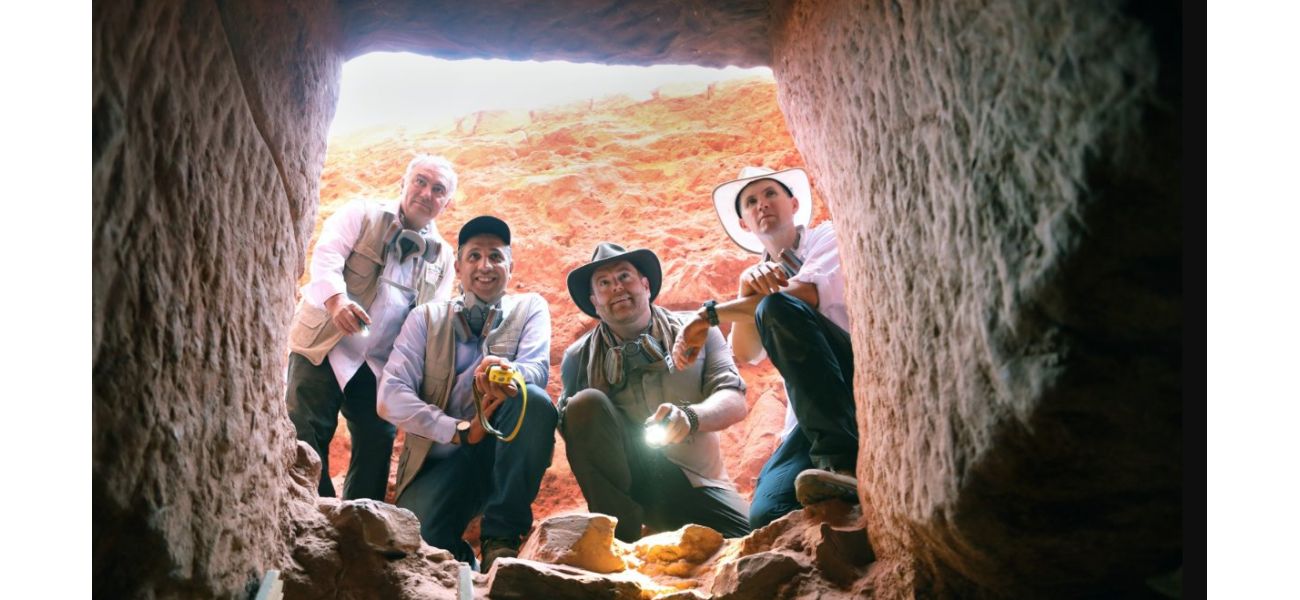Ancient hidden tomb containing 'Holy Grail cup' discovered beneath famous Indiana Jones landmark.
A moment where history mirrored art in a truly remarkable way.
October 15th 2024.

Dr. Fares Braizat, Fadi Balawi, Josh Gates, and Dr. Pearce Paul Creasman have recently uncovered a remarkable discovery that has captured the attention of archaeologists and adventure enthusiasts alike. Deep within the ancient city of Petra in Jordan, hidden below a site featured in one of the iconic Indiana Jones films, lies a secret tomb filled with a collection of skeletons.
This remarkable find, made in August after years of speculation, is believed to be the resting place of at least 12 individuals dating back 2,000 years. The location of the tomb, underneath the elaborate monument known as the Khaznah or "Treasury," had long been a subject of curiosity and intrigue. Using ground-penetrating radar, archaeologists were finally able to confirm the existence of something hidden beneath the surface, leading the Jordanian government to grant permission for an excavation.
As the team delved deeper into the tomb, they discovered 12 well-preserved human skeletons, along with various artifacts made of bronze, iron, and ceramic. This find, believed to be the largest collection of human remains in one place within Petra, sheds light on the lives of the ancient Nabataean people who inhabited the region.
The excavation was led by Dr. Pearce Paul Creasman from the American Center of Research, who invited Josh Gates, host of the Discovery Channel's Expedition Unknown series, to document the process. During the dig, the film crew stumbled upon a skeleton holding a ceramic chalice that closely resembled the Holy Grail depicted in the Indiana Jones film. It was a moment that Gates described as "history imitating art."
The discovery of this tomb not only provides a rare glimpse into the lives of the Nabataeans but also raises questions about their culture and customs. The skeletons and artifacts will be further examined using DNA analysis to determine if they were related and to date them. Other research may reveal information about their diet and daily activities.
The location of the tomb, directly in front of the famous Khaznah monument, adds to its significance. It was believed to be the final resting place of the Holy Grail in the film, and now it has become the actual resting place for these ancient individuals. This prime real estate also suggests that the individuals buried here were of high importance in their society.
The discovery of this tomb has opened up new possibilities for understanding the history of Petra and the Nabataean people. Despite being a highly advanced civilization with the ability to read and write, the Nabataeans left little written history. Their secrets and mysteries remain, adding to the allure of the ancient city. Petra, with its unique architecture and fascinating mysteries, was even voted as one of the New Seven Wonders of the World.
As the team continues to study the skeletons and artifacts, they hope to uncover more information about the lives and customs of the Nabataeans. Perhaps this discovery will provide a better understanding of the purpose of the Khaznah monument, which has long eluded historians. For Josh Gates, this find is just the beginning of unraveling the mysteries of Petra and its inhabitants.
This remarkable find, made in August after years of speculation, is believed to be the resting place of at least 12 individuals dating back 2,000 years. The location of the tomb, underneath the elaborate monument known as the Khaznah or "Treasury," had long been a subject of curiosity and intrigue. Using ground-penetrating radar, archaeologists were finally able to confirm the existence of something hidden beneath the surface, leading the Jordanian government to grant permission for an excavation.
As the team delved deeper into the tomb, they discovered 12 well-preserved human skeletons, along with various artifacts made of bronze, iron, and ceramic. This find, believed to be the largest collection of human remains in one place within Petra, sheds light on the lives of the ancient Nabataean people who inhabited the region.
The excavation was led by Dr. Pearce Paul Creasman from the American Center of Research, who invited Josh Gates, host of the Discovery Channel's Expedition Unknown series, to document the process. During the dig, the film crew stumbled upon a skeleton holding a ceramic chalice that closely resembled the Holy Grail depicted in the Indiana Jones film. It was a moment that Gates described as "history imitating art."
The discovery of this tomb not only provides a rare glimpse into the lives of the Nabataeans but also raises questions about their culture and customs. The skeletons and artifacts will be further examined using DNA analysis to determine if they were related and to date them. Other research may reveal information about their diet and daily activities.
The location of the tomb, directly in front of the famous Khaznah monument, adds to its significance. It was believed to be the final resting place of the Holy Grail in the film, and now it has become the actual resting place for these ancient individuals. This prime real estate also suggests that the individuals buried here were of high importance in their society.
The discovery of this tomb has opened up new possibilities for understanding the history of Petra and the Nabataean people. Despite being a highly advanced civilization with the ability to read and write, the Nabataeans left little written history. Their secrets and mysteries remain, adding to the allure of the ancient city. Petra, with its unique architecture and fascinating mysteries, was even voted as one of the New Seven Wonders of the World.
As the team continues to study the skeletons and artifacts, they hope to uncover more information about the lives and customs of the Nabataeans. Perhaps this discovery will provide a better understanding of the purpose of the Khaznah monument, which has long eluded historians. For Josh Gates, this find is just the beginning of unraveling the mysteries of Petra and its inhabitants.
[This article has been trending online recently and has been generated with AI. Your feed is customized.]
[Generative AI is experimental.]
0
0
Submit Comment





